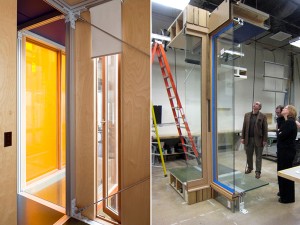Is it a product design or a building design?
It’s not that uncommon to see architects designing furniture and product designers involved with small buildings like street carts or garden sheds. In sustainable design terms, a common suggestion for architecture is that we get serious about manufactured housing, that is, housing where the components are manufactured offsite, then delivered and assembled on location. This idea, of course, has a long history as “prefab” or “prefabricated housing.”
Architecture firm Keiran Timberlake is known for promoting high precision manufactured housing, such that component parts are so reliable and interchangeable that you could buy and sell them on ebay when it is time to make modifications to your structure. Their Loblolly house (short video or a blog post) exemplifies this approach where wall components basically become products assembled into buildings–and disassembled later.
 The built detail (left) and the reconstructed detail (right)
The built detail (left) and the reconstructed detail (right)
from Loblolly house by Kieran Timberlake
In another example, using scenery design principles, Simon Woodroffe has introduced a multi-use living space that maximizes fold-away furniture and transformer floors and walls to make the most of very small apartments. It’s the “swiss army knife” apartment for living in almost any high cost city on earth, he claims. In this case the furniture is the home–or to the point of this post, the furniture design is the home design. Woodroffe is the founder of British sushi chain Yo! Sushi and calls the home venture Yo! Home.
 Yo!Home: the bedroom elevates to reveal a living area
Yo!Home: the bedroom elevates to reveal a living area
In this terrain of manufactured buildings we have the potential for huge efficiencies of materials, space and energy, as well as the potential to much more easily reuse the parts (design for disassembly). Futher, this kind of flexible and multi-function approach may suit our increasingly nomadic work life as well.
Here’s a question I put to you and your students: what kind of training best prepares a designer for this type of bulding-as-product? Let me know what you think in the comments.
If you find Thursday inspirations useful, subscribe up in the right hand corner or pass the word to colleagues.
Subscribe
About
Join me on the first Thursday of the month for ideas, tips and inspiration for teaching and researching sutainable design. Sign up to get these posts in your inbox.


